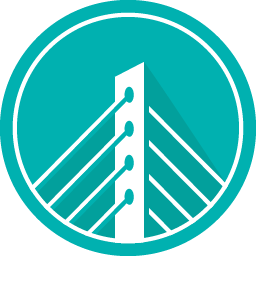Neighborhood-Scale Sustainable Development Case Study
Neighborhood Overview
The Seaholm Ecodistrict is an 85-acre brownfield site in Austin, TX that is being redeveloped into a vibrant, sustainable, cultural hub for the downtown area. The site covers 22 city blocks with over nine blocks of City owned land, most of which served as Austin’s primary utilities for several decades, providing businesses and residents with power and water. The area is anchored by the decommissioned Seaholm Power Plant, which now sits as an iconic centerpiece of this historic industrial area.
In 2001, the City of Austin completed a Seaholm District Master Plan to establish a context for the redevelopment and reuse of the Seaholm Power Plant site as an integrated, mixed-use public attraction prioritizing compact and connected neighborhoods, sustainably managed water resources, workforce and local business investment, green infrastructure and household affordability.
Planned and completed infrastructure improvements include a new 200,000 square foot Central Library, extension of a promenade along Cesar Chavez Avenue that is in accordance with Austin’s “Great Streets” design standards, expansion of the downtown district cooling system, a boutique hotel, 1,475 units of multi-family housing, and new office and retail space that will support up to 5,000 new jobs. A new multi-modal transportation network includes planned bus transit, bike sharing, car sharing, hike-and-bike trail connections and a five-mile cross-city route connecting with the Lance Armstrong Bikeway. The Shoal Creek urban waterway that runs through the district, culminating at Lady Bird Lake, and providing an opportunity for stream bank restoration, habitat creation, native plantings and natural drainage enhancements.
Seaholm + Target Cities: Advancing Sustainable District-Scale Development
In 2012, a team of stakeholders from the City of Austin attended the annual EcoDistricts Incubator, a three-day intensive designed to accelerate EcoDistricts- modeled urban regeneration projects across North American communities. Though the Seaholm Ecodistrict’s existing master plan featured sustainability strategies for individual parcels in the district, the team came to the Incubator to develop goals and strategies for the district as a whole.
The City of Austin turned to EcoDistricts again in 2014, as it saw opportunity to apply the EcoDistricts Protocol to inform the district’s existing master plan implementation. The Seaholm Ecodistrict was formed to serve as a backbone organization that would move the implementation of the Master Plan forward in partnership with the City of Austin and other stakeholder organizations.
The Seaholm Ecodistrict joined EcoDistricts’ Target Cities program in 2014 to advance its capacity, governance and leadership in the area of neighborhood development. The Target Cities program included training, technical assistance, and peer-to-peer networking to help projects align stakeholder interests and responsibilities, develop a long-term governance model and strategy framework, complete an EcoDistricts Assessment and Roadmap (integrated footprint analysis and project identification), and support the launch of catalytic projects. EcoDistricts gathered stakeholders from the Seaholm team for several onsite workshops customized to their project, as well as two workshops involving the entire 11-project cohort. The events were designed around the Protocol’s three implementation phases — Formation, Roadmap and Performance.
Over the course of the Target Cities program, the Seaholm team traveled to five U.S. cities for four workshops, one charrette and one convening hosted at the 2014 EcoDistricts Summit. Each host city — including Boston, MA, Washington, DC, Atlanta, GA and Denver, CO — acted as a learning laboratory in which Target Cities members saw other communities’ projects first-hand and shared stories and strategies. After Target Cities concluded at the end of 2016, Seaholm leadership evaluated its progress and continued challenges.
Early Wins
 PLACE: To empower its sense of community and place, in 2015 the Seaholm Ecodistrict created a logo and graphic identify epitomizing. the spirit of the iconic Seaholm power plant. The logo provides a visual foundation and shared identity for residents and visitors, and is intended for use on wayfinding materials such as banners, flyers, street signs and posters throughout the district. The new vision for Seaholm knits together the fabric of an off-limits brownfield into the heart of downtown by creating pedestrian and bike connections, public space and a sense of there. To enliven the district, the City of Austin Art in Public Places program completed eight public art installations in the Seaholm Ecodistrict in Fall 2016, including LED installations, child-engaging sculptures, traffic-calming art bollards, murals and digital placemaking.
PLACE: To empower its sense of community and place, in 2015 the Seaholm Ecodistrict created a logo and graphic identify epitomizing. the spirit of the iconic Seaholm power plant. The logo provides a visual foundation and shared identity for residents and visitors, and is intended for use on wayfinding materials such as banners, flyers, street signs and posters throughout the district. The new vision for Seaholm knits together the fabric of an off-limits brownfield into the heart of downtown by creating pedestrian and bike connections, public space and a sense of there. To enliven the district, the City of Austin Art in Public Places program completed eight public art installations in the Seaholm Ecodistrict in Fall 2016, including LED installations, child-engaging sculptures, traffic-calming art bollards, murals and digital placemaking.
The Seaholm Ecodistrict’s 2nd Street extension will be designed as a ‘Festival Street’ extending from the Seaholm Plaza to Shoal Creek. The design incorporates sidewalk improvements, pedestrian crossings, paving patterns, street furniture, native landscaping, removable traffic-calming bollards and an urban tree canopy. The planting areas along 2nd Street will provide stormwater treatment to minimize urban runoff.
 HEALTH + WELLBEING: The Seaholm Ecodistrict partnered with Farm to Work, a popular fresh produce delivery service, to serve all employees at the new Central Library beginning in early 2017. Farm to Work promotes locally grown food and offers education about healthy food systems and sustainable farming to consumers and their families.
HEALTH + WELLBEING: The Seaholm Ecodistrict partnered with Farm to Work, a popular fresh produce delivery service, to serve all employees at the new Central Library beginning in early 2017. Farm to Work promotes locally grown food and offers education about healthy food systems and sustainable farming to consumers and their families.

 RESILIENCE + RESOURCE REGENERATION: The Seaholm Ecodistrict features multiple micro-solar installations including a solar kiosk and Soofa solar benches. An Electric Drive solar kiosk and free charging station opened in October 2016. Three Soofa solar benches have been installed in the district, providing the public with phone, tablet and computer charging stations powered by 100% solar energy.
RESILIENCE + RESOURCE REGENERATION: The Seaholm Ecodistrict features multiple micro-solar installations including a solar kiosk and Soofa solar benches. An Electric Drive solar kiosk and free charging station opened in October 2016. Three Soofa solar benches have been installed in the district, providing the public with phone, tablet and computer charging stations powered by 100% solar energy.
 LIVING INFRASTRUCTURE: The new Central Library includes a 350,000-gallon rainwater harvesting system with a cistern developed through the adaptive reuse of an abandoned underground concrete pump room in the adjacent electric substation. This rainwater harvesting system will enhance water quality and protect riparian habitat from pollutants of the adjacent Shoal Creek and nearby Lady Bird Lake.
LIVING INFRASTRUCTURE: The new Central Library includes a 350,000-gallon rainwater harvesting system with a cistern developed through the adaptive reuse of an abandoned underground concrete pump room in the adjacent electric substation. This rainwater harvesting system will enhance water quality and protect riparian habitat from pollutants of the adjacent Shoal Creek and nearby Lady Bird Lake.
Lessons Learned + Continued Challenges
Each Target City was evaluated by both its internal staff and board and EcoDistricts personnel at the end of the two-year engagement period. The comments below reflect shared assessments by all parties and describe both the opportunities and challenges that the Seaholm Ecodistrict faces in the effort to regenerate the site.
- As a brownfield redevelopment that includes eight City-owned blocks, the Seaholm Ecodistrict is an ideal scale to test innovative sustainable solutions. With leadership from several City departments, implementation hasn’t been a tremendous barrier. However, the Seaholm Ecodistrict already was in an advanced stage of planning when stakeholders initially engaged with EcoDistricts. Because of this, project implementation has moved forward rapidly, but it’s been more difficult to integrate the EcoDistricts Protocol into projects already under development.
- Funding continues to be an issue in completing all of the projects outlined in the Roadmap created by the district. The district team has hired a consultant to research financing options.
- Since there currently aren’t any residents in the district, City leaders must envision how to incorporate equity into their outcomes through the development of a process for creating and monitoring a community benefits agreement, affordable housing development, accessibility, health and wellness and other key issues.
- The Seaholm Ecodistrict sits in an ideal geographic location for its resource regeneration initiatives. Encompassing the mouth of the Shoal Creek watershed and abutting Lady Bird Lake, the site is rich in habitat and water resources. The area also has tremendous potential for connectivity, from the Pfluger Pedestrian Bridge across the Lake to the planned Lone Star Rail and Capital Metro Rail terminal.
Next Steps
- Support Seaholm through meeting EcoDistricts Certified requirements with project management. As neighborhood leadership moves through the certification process, EcoDistricts can provide technical support, training and serve as an information hub to connect the district with others for peer learning and the application of best practices. (2017-2019)
- Create and devise key anti-displacement and sound equity engagement policies for the City. (2018-2020)
In Their Own Words
“The Seaholm plan featured sustainability strategies for individual parcels, but not overarching goals and strategies for the neighborhood as whole. The EcoDistricts helped us solidify and expand efforts and better articulate what Austin is trying to achieve at the neighborhood scale.”
– Lucia Athens, Chief Sustainability Officer, City of Austin
